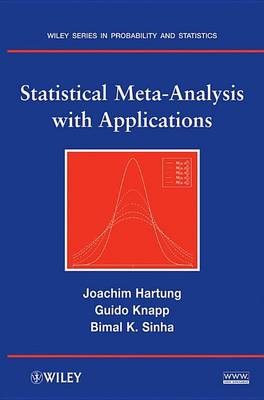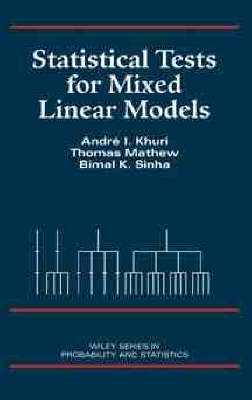Wiley Series in Probability and Statistics
4 primary works
Book 360
Designed to help motivate the learning of advanced calculus by demonstrating its relevance in the field of statistics. Features detailed coverage of optimization techniques and their applications in statistics. Introduces approximation theory. Each chapter contains a significant amount of examples and exercises as well as additional reading lists.
Book 738
Statistical Meta-Analysis with Applications
by Joachim Hartung, Guido Knapp, and Bimal K. Sinha
Published 22 August 2008
An accessible introduction to performing meta-analysis across various areas of research The practice of meta-analysis allows researchers to obtain findings from various studies and compile them to verify and form one overall conclusion. Statistical Meta-Analysis with Applications presents the necessary statistical methodologies that allow readers to tackle the four main stages of meta-analysis: problem formulation, data collection, data evaluation, and data analysis and interpretation. Combining the authors' expertise on the topic with a wealth of up-to-date information, this book successfully introduces the essential statistical practices for making thorough and accurate discoveries across a wide array of diverse fields, such as business, public health, biostatistics, and environmental studies. Two main types of statistical analysis serve as the foundation of the methods and techniques: combining tests of effect size and combining estimates of effect size.
Additional topics covered include: Meta-analysis regression procedures Multiple-endpoint and multiple-treatment studies The Bayesian approach to meta-analysis Publication bias Vote counting procedures Methods for combining individual tests and combining individual estimates Using meta-analysis to analyze binary and ordinal categorical data Numerous worked-out examples in each chapter provide the reader with a step-by-step understanding of the presented methods. All exercises can be computed using the R and SAS software packages, which are both available via the book's related Web site. Extensive references are also included, outlining additional sources for further study. Requiring only a working knowledge of statistics, Statistical Meta-Analysis with Applications is a valuable supplement for courses in biostatistics, business, public health, and social research at the upper-undergraduate and graduate levels. It is also an excellent reference for applied statisticians working in industry, academia, and government.
Additional topics covered include: Meta-analysis regression procedures Multiple-endpoint and multiple-treatment studies The Bayesian approach to meta-analysis Publication bias Vote counting procedures Methods for combining individual tests and combining individual estimates Using meta-analysis to analyze binary and ordinal categorical data Numerous worked-out examples in each chapter provide the reader with a step-by-step understanding of the presented methods. All exercises can be computed using the R and SAS software packages, which are both available via the book's related Web site. Extensive references are also included, outlining additional sources for further study. Requiring only a working knowledge of statistics, Statistical Meta-Analysis with Applications is a valuable supplement for courses in biostatistics, business, public health, and social research at the upper-undergraduate and graduate levels. It is also an excellent reference for applied statisticians working in industry, academia, and government.
Book 744
Statistical Tolerance Regions
by Kalimuthu Krishnamoorthy and Thomas Mathew
Published 10 November 2008
A modern and comprehensive treatment of tolerance intervals and regions The topic of tolerance intervals and tolerance regions has undergone significant growth during recent years, with applications arising in various areas such as quality control, industry, and environmental monitoring. Statistical Tolerance Regions presents the theoretical development of tolerance intervals and tolerance regions through computational algorithms and the illustration of numerous practical uses and examples. This is the first book of its kind to successfully balance theory and practice, providing a state-of-the-art treatment on tolerance intervals and tolerance regions. The book begins with the key definitions, concepts, and technical results that are essential for deriving tolerance intervals and tolerance regions.
Subsequent chapters provide in-depth coverage of key topics including: Univariate normal distribution Non-normal distributions Univariate linear regression models Nonparametric tolerance intervals The one-way random model with balanced data The multivariate normal distribution The one-way random model with unbalanced data The multivariate linear regression model General mixed models Bayesian tolerance intervals A final chapter contains coverage of miscellaneous topics including tolerance limits for a ratio of normal random variables, sample size determination, reference limits and coverage intervals, tolerance intervals for binomial and Poisson distributions, and tolerance intervals based on censored samples. Theoretical explanations are accompanied by computational algorithms that can be easily replicated by readers, and each chapter contains exercise sets for reinforcement of the presented material. Detailed appendices provide additional data sets and extensive tables of univariate and multivariate tolerance factors. Statistical Tolerance Regions is an ideal book for courses on tolerance intervals at the graduate level.
It is also a valuable reference and resource for applied statisticians, researchers, and practitioners in industry and pharmaceutical companies.
Subsequent chapters provide in-depth coverage of key topics including: Univariate normal distribution Non-normal distributions Univariate linear regression models Nonparametric tolerance intervals The one-way random model with balanced data The multivariate normal distribution The one-way random model with unbalanced data The multivariate linear regression model General mixed models Bayesian tolerance intervals A final chapter contains coverage of miscellaneous topics including tolerance limits for a ratio of normal random variables, sample size determination, reference limits and coverage intervals, tolerance intervals for binomial and Poisson distributions, and tolerance intervals based on censored samples. Theoretical explanations are accompanied by computational algorithms that can be easily replicated by readers, and each chapter contains exercise sets for reinforcement of the presented material. Detailed appendices provide additional data sets and extensive tables of univariate and multivariate tolerance factors. Statistical Tolerance Regions is an ideal book for courses on tolerance intervals at the graduate level.
It is also a valuable reference and resource for applied statisticians, researchers, and practitioners in industry and pharmaceutical companies.
Book 906
Statistical Tests for Mixed Linear Models
by Andre I. Khuri, Thomas Mathew, and Bimal K. Sinha
Published 17 February 1998
An advanced discussion of linear models with mixed or random effects. In recent years a breakthrough has occurred in our ability to draw inferences from exact and optimum tests of variance component models, generating much research activity that relies on linear models with mixed and random effects. This volume covers the most important research of the past decade as well as the latest developments in hypothesis testing. It compiles all currently available results in the area of exact and optimum tests for variance component models and offers the only comprehensive treatment for these models at an advanced level. Statistical Tests for Mixed Linear Models:* Combines analysis and testing in one self-contained volume.* Describes analysis of variance (ANOVA) procedures in balanced and unbalanced data situations.* Examines methods for determining the effect of imbalance on data analysis.* Explains exact and optimum tests and methods for their derivation.* Summarizes test procedures for multivariate mixed and random models.* Enables novice readers to skip the derivations and discussions on optimum tests.Offers plentiful examples and exercises, many of which are numerical in flavor.*
Provides solutions to selected exercises. Statistical Tests for Mixed Linear Models is an accessible reference for researchers in analysis of variance, experimental design, variance component analysis, and linear mixed models. It is also an important text for graduate students interested in mixed models.
Provides solutions to selected exercises. Statistical Tests for Mixed Linear Models is an accessible reference for researchers in analysis of variance, experimental design, variance component analysis, and linear mixed models. It is also an important text for graduate students interested in mixed models.


